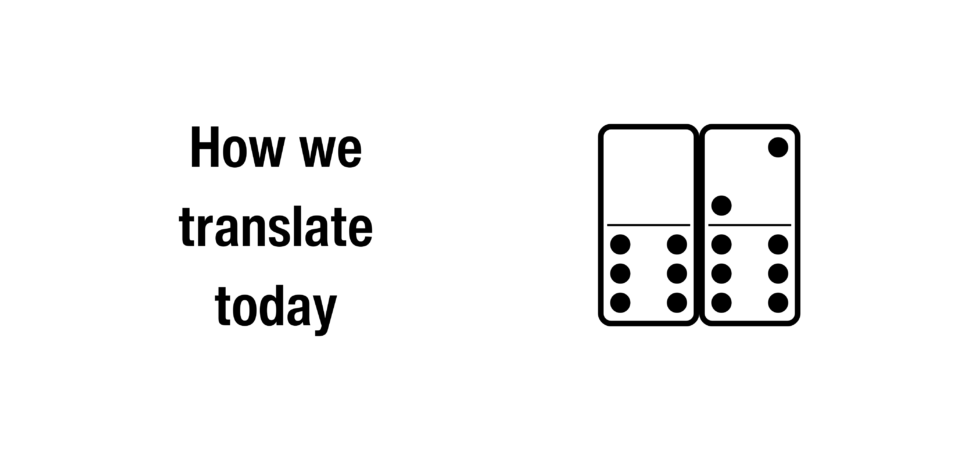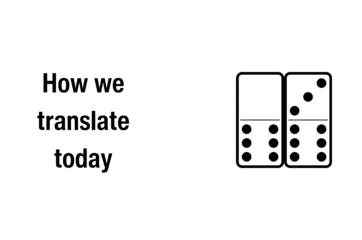From rules to robots: the history of machine translation

Language is as old as humanity itself, but the dream of automatic translation is far more recent. The idea that a machine could instantly translate words from one language to another captured imaginations long before the technology existed to support it. Today, we take tools like Google Translate or DeepL for granted. However, the road to modern machine translation is a story of decades of trial, error, innovation and integration. Understanding the history of machine translation also highlights why human expertise and language services providers (LSPs), like SwissGlobal, remain essential for quality and nuance.
1950s–1960s: the first experiments in the history of machine translation
The earliest attempts at machine translation emerged in the 1950s, when computer science was still in its infancy. One of the most famous demonstrations was the Georgetown-IBM experiment of 1954, in which a computer successfully translated 60 Russian sentences into English using a small vocabulary of 250 words and six grammar rules. While primitive by today’s standards, the experiment generated enormous optimism and was widely reported as the beginning of automated translation.
However, the enthusiasm quickly ran into challenges. The ALPAC (Automatic Language Processing Advisory Committee) Report of 1966, commissioned by the United States government, concluded that machine translation had failed to deliver useful results compared to human translators. Funding was cut, research slowed, and for nearly a decade, machine translation remained on the margins of computational linguistics.
1970s–1980s: rule-based systems and the revival of machine translation
Despite setbacks, the 1970s and 1980s witnessed a revival of interest in machine translation, particularly through rule-based machine translation (RBMT). This approach relied on linguists programming grammar rules and bilingual dictionaries into systems. Programs like SYSTRAN, first developed in the late 1960s, gained widespread use, particularly by the European Commission, which required translations across multiple languages for its official documents.
RBMT was effective for technical and repetitive texts where terminology could be controlled. However, it was slow to build and maintain because every language pair required its own extensive set of rules. The quality of the service was adequate but often rigid, resulting in translations that lacked natural flow.
1990s: statistical machine translation and data-driven progress
The 1990s marked a major shift with the rise of statistical machine translation (SMT). Instead of manually programming grammar rules, SMT systems analysed large bilingual corpora to find patterns and probabilities. The approach was pioneered by IBM’s Candide project in the early 1990s and later adopted by companies such as Google.
SMT produced smoother translations than RBMT in many cases. However, the results often contained grammatical errors and struggled with idiomatic language. Nevertheless, SMT demonstrated the power of data-driven approaches and laid the foundation for modern translation technology.
Google Translate, launched a few years later in 2006, originally utilised SMT and quickly scaled to support dozens of languages by leveraging the vast multilingual content available on the web.
Early 2000s: machine translation with post-editing (MTPE)
By the early 2000s, it became clear that fully automatic, high-quality machine translations were still a distant dream. This led to the rise of machine translation with post-editing (MTPE), where human translators edit machine outputs to achieve the required accuracy and fluency.
The European Union and other international organisations were early adopters of MTPE, using machine output as a draft to expedite human translation. Language service providers also began offering MTPE as a distinct service, combining cost efficiency with human oversight. This approach quickly became a cornerstone of professional translation workflows.
In 2017, the International Organisation for Standardisation (ISO) introduced ISO 18587, which formally set requirements for post-editing machine translation output. This standard established guidelines for professional post-editors, ensuring that MTPE was applied consistently and with verifiable quality. Today, MTPE remains one of the most widely used hybrid approaches in the translation industry, striking a balance between efficiency and the human ability to interpret nuance, tone, and cultural context.
2010s: neural machine translation and a breakthrough in quality
A true breakthrough came with neural machine translation (NMT) in the 2010s. Unlike SMT, which relied on phrase probabilities, NMT uses artificial neural networks that process entire sentences at once, learning contextual relationships between words. The results are more fluent, accurate and natural-sounding.
Google switched to NMT in 2016, and the improvement was immediately noticeable. Other major players, such as Microsoft Translator, Amazon Translate and DeepL, also embraced NMT. DeepL, launched in 2017, quickly gained recognition for producing exceptionally natural translations, especially in European languages, thanks to its use of advanced neural architectures and large parallel corpora.
The introduction of NMT has transformed the industry, making machine translation suitable for a wider range of content. However, human review remains essential for sensitive or nuanced texts.
2020s: AI tools and the integration of machine translation into daily life
The 2020s have brought machine translation into everyday use, powered by advances in artificial intelligence and cloud-based tools. NMT is now enhanced by transformer models, such as Google’s BERT and OpenAI’s GPT, which excel at understanding context and meaning across entire documents rather than isolated sentences.
These large language models (LLMs) are expanding the possibilities of machine translation. They can adapt to stylistic preferences, handle idiomatic expressions more effectively, and even generate translations that accurately reflect the brand’s voice. However, while their fluency is impressive, their tendency to “hallucinate” or invent content means they are not yet reliable for high-stakes business communication.
For professional use, AI tools are being integrated into translation management systems (TMS) and computer-assisted translation (CAT) platforms. Customisable engines can now be trained on in-domain datasets, aligning output with a company’s terminology and writing style. Services such as DeepL with glossary integration or machine translation engines fine-tuned with corporate datasets allow organisations to embed machine translation directly into their workflows.
AI also extends beyond text-to-text translation. Speech recognition, voice-to-text, and real-time speech translation have become more common in video conferencing and multilingual chatbots. These tools are breaking down barriers in global collaboration, making instant multilingual communication part of everyday business life.
The future: hybrid approaches and human expertise
While machine translation has advanced dramatically, the role of the human translator remains central. The future lies in hybrid approaches that combine machine translation, AI tools and human expertise. Post-editing is becoming more specialised, with different levels depending on the content’s purpose.
For companies operating internationally, the challenge is not choosing between humans and machines, but finding the right balance.
What does the history of machine translation mean for your business?
The takeaways are practical.
- Start with a content audit. Segment your material by risk, reusability and shelf life. Human experts review high-risk or reputation-sensitive content. Low-risk, repetitive content is a good candidate for machine translation with post-editing.
- Treat data as a product. Clean bilingual guides, translation memories and glossaries are strategic assets. These texts ensure quality, adaptability, and accuracy in all your communication.
- Measure with more than a single score. Automatic metrics are useful for regression testing, but they are not the goal. Combine automated checks with human evaluation focused on accuracy, style, inclusivity and purpose.
- Integrate machine translation into the workflow. The value comes when machine translation, TMs, terminology and human review sit in one pipeline with clear quality targets per content type.
- Protect privacy and IP. If your content is sensitive, use dedicated machine translation infrastructure and adhere to strict data handling protocols. Avoid sending confidential text to public endpoints that may reuse inputs for training.
How SwissGlobal’s machine translation services help your business
The history of machine translation shows that technology evolves, but human expertise remains constant. At SwissGlobal, we build customised workflows that combine machine translation with the expertise of professional linguists. This means your business benefits from speed and efficiency without compromising on accuracy, tone, or confidentiality.
Our machine translation services are designed to give you speed, flexibility and accuracy without compromising quality or security. Depending on your goals, we provide a range of solutions that support your multilingual communication needs:
- Secure machine translation: Translations run on secure servers, and all texts are deleted immediately to keep your data confidential.
- Incorporating glossaries and style guides: We integrate your terminology and brand style guide so every translation reflects your company’s language.
- Glossary creation service: We create tailored glossaries that standardise terminology across all your projects and languages.
- Custom editor: Our platform combines MT and copywriting tools, letting you refine translations in a familiar environment.
- LLM translation: Large language models deliver fluent, brand-consistent translations that often need little or no post-editing.
- Client-specific machine translation engines: We train machine translation engines on your company data for translations that match your tone, style and quality standards.
- Machine translation with post-editing: Drafts created with the latest machine translation tools are post-edited to meet ISO 18587 standards, guaranteeing you speed and accuracy.
With us, you get more than translation technology. You gain a trusted partner who blends the latest machine translation tools with human expertise, ensuring that your multilingual content remains accurate, consistent, and tailored to your audience.
Contact us today for all your translation needs.
-
history of machine translation
MTPE
Post-Editing
translation services


